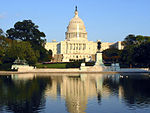Union Square (Washington, D.C.)
Landmarks in Washington, D.C.National MallSquares, plazas, and circles in Washington, D.C.United States Capitol grounds

Union Square is an 11-acre public plaza at the foot of Capitol Hill in Washington, D.C., United States. It encompasses the Ulysses S. Grant Memorial (1924) and the 6-acre Capitol Reflecting Pool (1971) and is just west of the United States Capitol building. Views differ as to whether the Square is just east of the National Mall or is itself the eastern end. Interstate 395 transits the Third Street Tunnel just beneath Union Square. The George Gordon Meade Memorial (1927) formerly stood in the northwest section of Union Square; that memorial now stands near the intersection of Constitution Avenue and Pennsylvania Avenue, NW.
Excerpt from the Wikipedia article Union Square (Washington, D.C.) (License: CC BY-SA 3.0, Authors, Images).Union Square (Washington, D.C.)
3rd Street Tunnel, Washington
Geographical coordinates (GPS) Address Nearby Places Show on map
Geographical coordinates (GPS)
| Latitude | Longitude |
|---|---|
| N 38.8898 ° | E -77.0137 ° |
Address
3rd Street Tunnel (Center Leg Freeway)
3rd Street Tunnel
20515 Washington
District of Columbia, United States
Open on Google Maps










